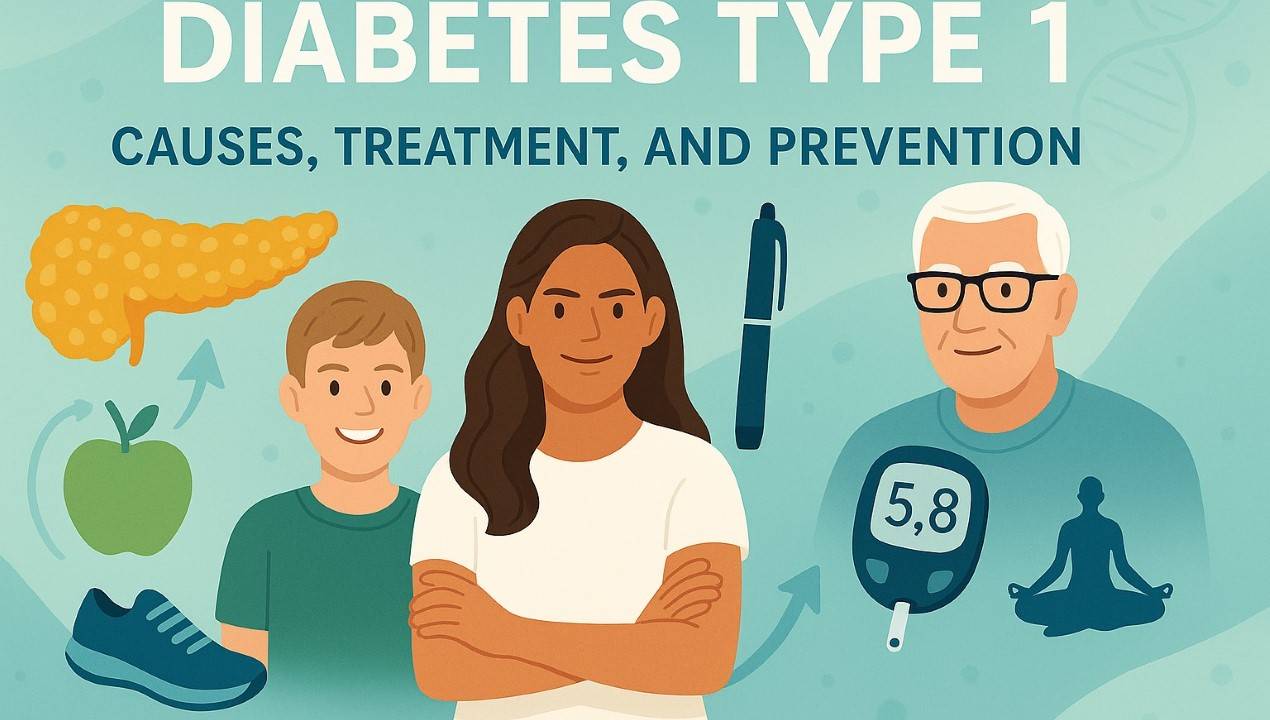Diabetes Type 1 is a lifelong condition where the body stops making insulin, a hormone that controls blood sugar. Immune cells impair the pancreas, halting insulin production and letting sugar build up. It may cause severe heart and kidney issues. The good news is that people with insulin therapy can manage it with insulin therapy, healthy habits, and regular check-ups. I’ve seen people live vibrant lives by staying on top of their care, and it’s inspiring to see their determination.
What Is Diabetes Type 1?
It, sometimes called juvenile diabetes, is an autoimmune disease. Immune defences wipe out pancreatic insulin cells. Without insulin, sugar stays in the blood instead of being used for energy. This causes high blood sugar, which can lead to symptoms like thirst, tiredness, or weight loss. Type 1 diabetes, unlike type 2, stems from factors beyond lifestyle and can affect individuals of any age, often starting in youth. Experts call it a puzzle, requiring collective effort from patients, families, and doctors to manage.
Why Does Diabetes Type 1 Happen?
We don’t fully know what causes Type 1 diabetes, but it’s a combination of genetics and environmental factors. Here’s what we do know:
Genetics: Some genes, like HLA-DQ and HLA-DR, make people more likely to develop Type 1 diabetes. If a parent or sibling has it, the risk is higher, but it’s not certain.
Environmental Triggers:
- Certain viruses, like mumps or Coxsackie, might trigger the immune system to attack the pancreas.
- Early exposure to cow’s milk in babies could play a role, though research is still exploring this.
- Low levels of vitamin D in childhood might increase the risk.
Autoimmune Reaction: The immune system mistakenly destroys the pancreas’s insulin-making cells, leading to Type 1 diabetes.
One thing to clear up: Diabetes Type 1 is not caused by eating too much sugar or being inactive. People often claim this, but it’s untrue. This disorder is immune-driven, not lifestyle-based.
Read also : Top Differences Between Type 1 Diabetes and Type 2: Expert guide
Symptoms of Diabetes Type 1
Early detection of Type 1 diabetes averts complications. Symptoms often come on quickly and include:
- Feeling very thirsty and peeing a lot
- Losing weight without trying
- Feeling tired or weak
- Having blurry vision
- Dry mouth or skin
- Nausea or stomach pain
- Fruity-smelling breath
- Getting infections often or sores that heal slowly
Some people don’t notice symptoms at first. I’ve seen cases where Diabetes Type 1 was discovered during a routine doctor’s visit. If you or someone you know has these signs, see a doctor right away. If untreated, Type 1 diabetes can cause issues like kidney failure, nerve damage, or vision loss.
Who Is at Risk for Diabetes Type 1? (h3)
Anyone can develop Type 1 diabetes, but some things make it more:
| Risk Factor | Details |
| Ancestral Background. | Your risk rises if a close family member has type 1 diabetes. |
| Genetics | Certain genes, like HLA markers, are linked to a higher risk. |
| Age | Most common in kids, teens, and young adults, but it can happen at any age. |
| Geography | More common in people from Northern Europe. |
| Viral Infections | Viruses like mumps might trigger the autoimmune response. |
| Low Vitamin D | Not getting enough vitamin D as a child could raise the risk. |
Risk factors don’t guarantee Type 1 diabetes. Many affected individuals show no obvious risk factors. Recognizing the signs makes all the difference.
Treatment for Diabetes Type 1
Managing Type 1 diabetes takes daily effort, but it’s very possible with the right plan. Treatment includes insulin therapy, checking blood sugar, and living a healthy life. Here’s how it works:
Insulin Therapy
Since the body can’t make insulin, people with Diabetes Type 1 need to take insulin. There are a few types:
- Rapid-acting insulin: Taken before meals to control blood sugar during eating.
- Extended-release insulin keeps blood levels even with one or two daily doses.
- Intermediate-acting insulin: Taken twice daily for background insulin.
A doctor will figure out the best insulin type and dose for each person. Insulin pumps provide automatic delivery for some users. I have tried a demo of an insulin pump, and it’s amazing how it makes doing it easier, especially for busy people.
Blood Sugar Monitoring
Check blood sugar often. Insulin pumps provide automatic delivery for some users. I like CGMS because they reduce finger pricks and gives real-time updates.
Here’s a quick guide to monitor:
- Check before meals and at bedtime.
- Keep blood sugar at 80–130 mg/dl before eating.
- Adjust insulin or food based on the results.
Healthy Lifestyle Choices
A healthy lifestyle helps manage Diabetes Type 1:
- Focus on whole grains, lean proteins, and vegetables. Count carbs to match insulin doses.
- Stay active with exercises like biking or walking to reduce blood sugar. Try 30 minutes most days.
- Manage Stress: Stress can raise blood sugar. Try relaxing with yoga or deep breathing.
- Sleep Enough: Poor sleep can mess with blood sugar control.
I’ve seen people with Type 1 diabetes do so well by building these habits. It’s not always simple, but small steps make a big difference.
Can You Prevent Diabetes Type 1?
Right now, we can’t prevent Type 1 diabetes because it’s caused by genetics and environmental factors, which we don’t fully control. But some steps might lower the risk or delay it:
Breastfeeding: Breastfeeding babies for 3–6 months may reduce the risk.
- Vitamin D: Make sure kids get enough vitamin D from supplements or sunlight.
- Delay Cow’s Milk: Waiting until after 6 months to give cow’s milk might help.
- Watch for Symptoms: Early detection can prevent complications.
- Join Clinical Trials: Trials test new ways to prevent or treat Type 1 diabetes.
These steps don’t guarantee prevention, but they’re worth considering. I’ve seen families stay proactive by learning about type 1 diabetes risks, and it gives them a sense of control.
Complications of Untreated Diabetes Type 1
If Type 1 diabetes isn’t managed, it can cause serious problems:
- Heart Disease: High blood sugar damages blood vessels, raising the risk of heart attacks.
- Kidney Damage: Might eventually cause kidney failure.
- Nerve Damage: Often leads to numb, painful feet.
- Eye Problems: Untreated, it can lead to blindness.
- Infections: Slow-healing sores or frequent infections are common.
Starting treatment early prevents these issues. I’ve talked to people who caught Type 1 diabetes early, and they’re so glad they acted.
FAQS About Diabetes Type 1
Is Type 1 Diabetes Serious?
Yes, Diabetes Type 1 is serious. Without insulin, blood sugar spikes and damages key organs like the heart, kidneys, and eyes. But with insulin therapy, regular monitoring, and healthy habits, people can manage it well and avoid problems.
Can Type 1 diabetes keep you from a normal life?
Absolutely—people with Type 1 diabetes can lead vibrant lives. With insulin, check-ups, and a healthy lifestyle, they can work, exercise, travel, and more. I’ve seen friends with Type 1 diabetes run marathons and achieve their goals: it’s amazing!
How do Type 1 and Type 2 diabetes differ?
| Feature | Type 1 Diabetes | Type 2 Diabetes |
| Cause | Autoimmune; the body stops making insulin. | The body resists insulin or makes too little. |
| Onset | Often in kids or young adults. | Usually in adults but can start earlier. |
| Treatment | Insulin therapy is a must. | May use diet, exercise, pills, or insulin. |
| Lifestyle Role | Not caused by lifestyle. | Linked to obesity, inactivity, or diet. |
Type 1 diabetes happens when the body attacks itself, while type 2 is often tied to lifestyle or genetics. Both need careful management, but their causes and treatments are different.
What Helps Type 1 Diabetes?
To manage Diabetes Type 1, try these:
- Take insulin as prescribed.
- Check blood sugar regularly.
- Eat balanced meals and count carbs.
- Exercise to keep blood sugar stable.
- See a doctor for regular check-ups.
- Join support groups for emotional help.
I love how tools like CGMS manage Type 1 diabetes more easily. They give people more confidence and control.
Conclusion
Type 1 diabetes is tough but controllable. It’s caused by an autoimmune reaction, not lifestyle, and requires lifelong care. With insulin therapy, blood sugar monitoring, and healthy habits, people with Diabetes Type 1 can live vibrant, fulfilling lives. Prevention isn’t possible yet, but early detection and care change outcomes. I’ve seen how knowledge and support help people take charge of their health, and it’s truly uplifting.



